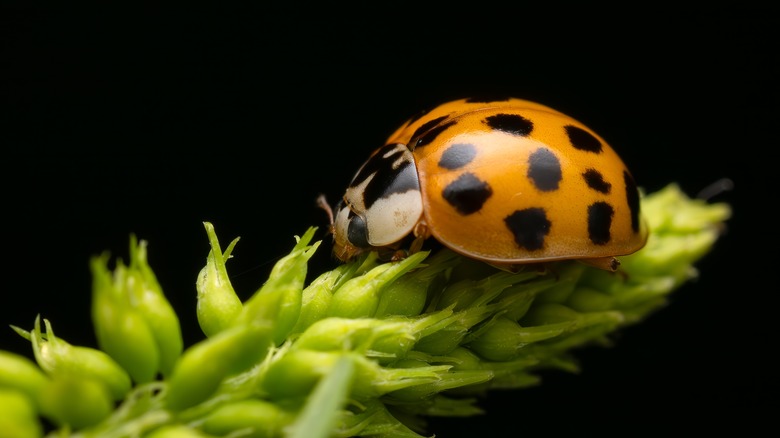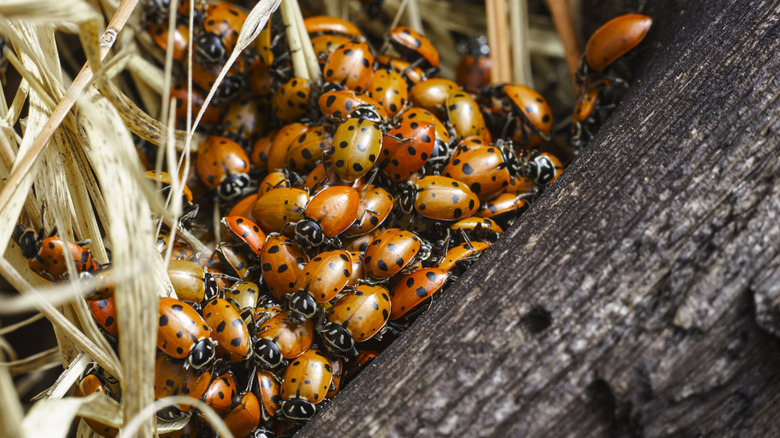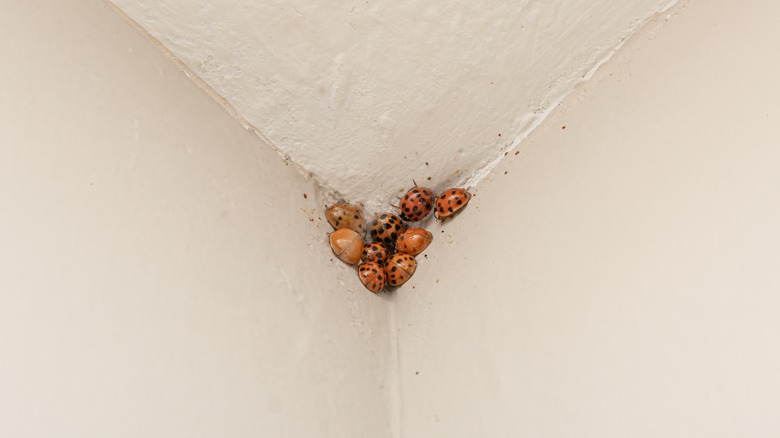The 5 Best Ways To Deal With Asian Lady Beetles
One of the best things you can do to benefit your landscape is to learn how to attract good insects that will get rid of destructive pests and pollinate your flowers. Insects like praying mantis, bees, and ladybugs all play an important role in the success of your garden. Another insect you might attract through your efforts is the Asian lady beetle (Harmonia axyridi), which can be easily mistaken for a ladybug. While these insects can provide much of the same benefits as their relatives, there are some key differences that can turn this beneficial bug into a pest.
Asian lady beetles were introduced into the United States near the turn of the 20th century to help control agricultural pests like aphids. In truth, they still complete that task, but there's something else they do — winter inside. To seek shelter from falling temperatures, they gather in warm places like the sunny side of buildings, around windows, or near doors. If you have any cracks or crevices around your home, Asian lady beetles could take them as an invitation inside, bringing their friends along with them. Before you know it, your aphid-eating guests become a problem. While they don't pose any real danger to humans or pets, Asian lady beetles can bite, release an offensive smell, and stain your rugs or other upholsteries. So, you might want to get rid of them quickly. That said, you have to do it in the right way.
Identification and prevention
Before tackling any Asian lady beetle problem, it might help to know if they're living in your garden or yard. One way to tell ladybugs apart from their twin is by looking at their color. While ladybugs are bright red, Asian lady beetles' color spans the spectrum from red to orange. Some say their color can even reach yellow. However, that still leaves the possibility you're looking at two similar red bugs, so the next thing you want to look at is their head. The Asian lady beetle has a signature white M or W behind its head, depending on which way you're looking at it. On the other hand, ladybugs only have small white cheeks, and the base of their head is black. Asian lady beetles are also more ovular than ladybugs.
If you find Asian lady beetles in your garden, there's no need to remove them because they do eat aphids and other small insects, just like ladybugs. But when they come into your home to nest for the winter, you probably don't want them to stay. So, what do you do? The first step to take is a preventative measure. Stopping these beetles from entering is the best course of action. Look for any cracks or openings outside and inside your home and seal them up before fall. Also, repair any holes in your window and door screens to keep the bugs out.
Discovering an infestation
Despite your efforts, Asian lady beetles might still find a way to sneak into your home. The most effective way to remove them at that point is to vacuum them up. You can either release them far from your home so they don't re-enter or let them overwinter in your vacuum bag outdoors and allow them to leave naturally in the spring. Keep in mind that the bugs release blood when they feel threatened, which smells bad and can stain, so removing them quickly is essential. After vacuuming, take your vacuum outside, remove the bag, and make sure no beetles are hiding in the tubes or elsewhere in your machine before bringing it back inside and installing a fresh bag.
While your instinct might be to use a broom to sweep them off your walls or windows in one or two fell swoops, doing so could trigger them to bleed, staining your home's interior. Using a vacuum sucks them off of their congregation spaces, giving them little time to secrete their smelly liquid.
Look in your kitchen cabinets
Another option to deal with Asian lady beetles taking up residence in your home is to turn toward some common household products you probably have in your kitchen right now. Even though killing these beneficial bugs you attracted to your garden isn't ideal, it is an option. If you want to go this route, the last thing you want to do is squish them. Doing so would guarantee they release a highly offensive odor and leave stains on whatever surface they previously occupied.
Instead, take a spray bottle and add one part water to either one part vinegar, dish soap, or rubbing alcohol. Spraying the concoction directly on the insect will likely kill it. Then, you can simply sweep the bugs up and remove them from your home. However, if they don't die immediately, the threat might be enough for them to secrete their defensive liquid, leaving a smell and possible stains anyway. Another spray that won't kill Asian lady beetles but might repel them consists of adding up to 10 drops of peppermint or wintergreen essential oil to some water. Applying the mixture around doors and windows might keep the pests away or prevent others from joining the group.
Capture the invaders
If killing these beneficial but sometimes annoying bugs isn't up your alley, consider a capture-and-release method. Although not as fast as vacuuming up this pest, you could create or buy a light trap that will attract the Asian lady beetles. These traps typically consist of a black light or another bulb, a funnel, and some type of container like a bucket or bottle. The beetles are drawn toward the light, go through the funnel, and become trapped in the container. Simply place the trap in the room with the insects at night, leave it overnight, and release the captives in the morning. Keep setting the trap until all the invaders are gone.
This light trap is not the same as a bug zapper, which also brings insects in using light but kills them on contact with an electrical current. The goal here is to gently attract the Asian lady beetles and return them to the outdoors so they can continue serving your garden the following year.
Last resort measures
While there are plenty of options to deal with Asian lady beetles, maybe your efforts have fallen short, or the infestation is just too great. In that case, it might be time to call in pest control professionals. Find a company that specializes in removing these particular insects and ask about the options they offer. They will likely have customized approaches to deal with the problem, depending on the scope of the infestation. Plus, the pros can examine your home for entry points to seal, identify food sources, create a perimeter around your property, and prevent further visitors from moving in.
Of course, there's always the option of waiting until the beetles leave on their own, as they don't pose any real threat or harm. If they are out of the way, like in an attic or basement, the best course of action might be to let them alone. Once the weather warms up and they leave, clean the area and seal their exit to stop them from returning the following year.





